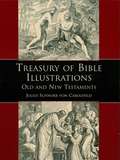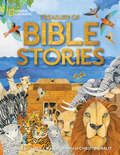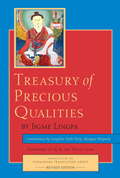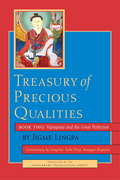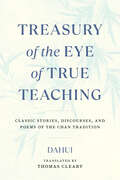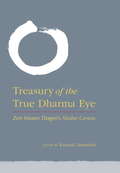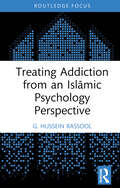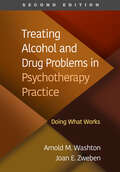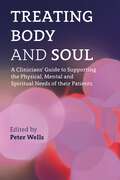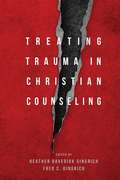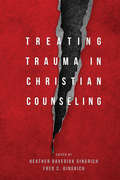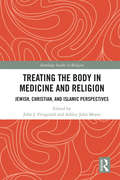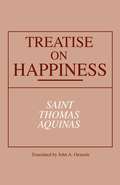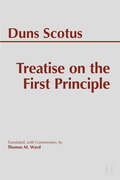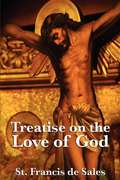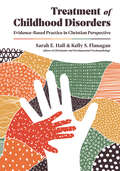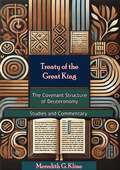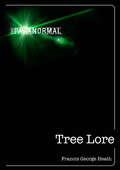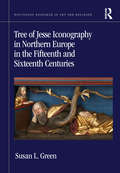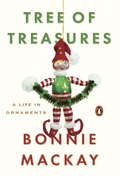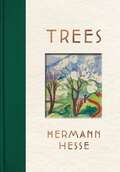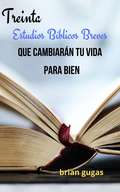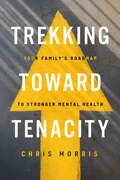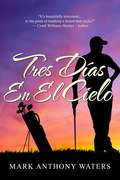- Table View
- List View
Treasury of Bible Illustrations: Old and New Testaments (Dover Pictorial Archive)
by Julius Schnorr von CarolsfeldPainstakingly reproduced from a rare volume of German engravings, this splendid work comprises all of the Bible's best-loved, most-quoted stories. Imaginative illustrations depict 105 episodes from the Old Testament and 74 scenes from the New Testament, accompanied by a citation of chapter and verse and the King James Version of the text.
Treasury of Bible Stories: Prophecy And Peril, Exile And Forgiveness
by Donna Jo NapoliThe timeless tales from the early books of the Bible have captivated generations. In this lush storybook, the fresh voice of lyrical storyteller Donna Jo Napoli and the lavish artwork of Christina Balit bring classic stories to life for a young, modern audience.Noah's Ark, Moses, David and Goliath, the ten plagues, Daniel and the lions' den, Jonah and the giant fish, and many more of the Bible's most powerful stories--27 in all--are compellingly retold in this beautifully illustrated treasury. Readers will be fascinated by the ancient people and events they encounter, surprised by some of the lesser known accounts revealed, and inspired by the lessons these tales impart. Stories cover important ground beyond religion, such as culture, history, and geography, and they touch on issues that remain relevant today--faith, loyalty, kindness, violence, generosity, greed, jealousy, and more. These accessible, readible stories give kids a rich picture of biblical times, which encourages them to think about our role in the world and to learn more. Napoli's magicial storytelling is sure to ignite children's imaginations. Along with Balit's stunning art, this is a book kids will want to explore again and again--a classic that families can read aloud together.
Treasury of Precious Qualities: Book One
by H. H. the Dalai Lama Jigme Lingpa Padmakara Translation Group Longchen Yeshe DorjeThis book is a translation of the first part of Jigme Lingpa's Treasury of Precious Qualities, which in a slender volume of elegant verses sets out briefly but comprehensively the Buddhist path according to the Nyingma school. The concision of the root text and its use of elaborate poetic language, rich in metaphor, require extensive explanation, amply supplied here by the commentary of Kangyur Rinpoche. The present volume lays out the teachings of the sutras in gradual stages according to the traditional three levels, or scopes, of spiritual endeavor. It begins with essential teachings on impermanence, karma, and ethics. Then, from the Hinayana standpoint, it describes the essential Buddhist teachings of the four noble truths and the twelve links of dependent arising. Moving on, finally, to the Mahayana perspective, it expounds fully the teachings on bodhichitta and the path of the six paramitas, and gives an unusually detailed exposition of Buddhist vows.
Treasury of Precious Qualities: Book Two
by Jigme Lingpa Padmakara Translation Group Longchen Yeshe Kangyur RinpocheThis second and concluding volume of Jigme Lingpa's classic Treasury of Precious Qualities is presented together with a detailed commentary by Kangyur Rinpoche. Composed in the form of a lamrim, or presentation of the stages of the path, the first volume set out the teachings of the sutras. The present volume continues this same structure and is a general description of the tantra teachings followed by an exposition of the Great Perfection, which in the Nyingma School of Tibetan Buddhism is regarded as the summit of all vehicles and the final stage of the path of spiritual training. The section on the tantras is a compendious presentation of all important issues: lineage, empowerment, the generation and perfection stages, and samaya. The section on the Great Perfection is arranged according to the classification of Ground, Path, and Result and gives an extremely clear introduction to the doctrinal background that underpins the practice of this unique system.
Treasury of the Eye of True Teaching: Classic Stories, Discourses, and Poems of the Chan Tradition
by DahuiThomas Cleary, one of America&’s most beloved translators of Buddhist texts, brings twelfth century Chan master Dahui&’s monumental compilation of teachings to life for the first time in English.Treasury of the Eye of True Teaching (Chinese Zhengfayanzang) stands as among the greatest classics of Chan (Chinese Zen) Buddhism, combining speeches, stories, dialogues, poems, and commentaries that the influential master Dahui (1089–1163) extracted from Chan lore. Compiled by Dahui&’s students during Song Dynasty China, this work is replete with the enigmatic, paradoxical wisdom for which Zen Buddhism is so well known.Central to this collection is the notion of &“great doubt&” in matters of language, conceptual thinking, and how we conceive of our existence. By working with great doubt through koan introspection and other meditative practices, a practitioner is able to push themself to the limits of ideas and concepts until a breakthrough to enlightenment is achieved. In the words of Dahui, &“Within great doubt there necessarily exists great enlightenment.&”A fascinating compendium of literary and spiritual puzzles, Treasury of the Eye of True Teaching will challenge and inspire readers to work with great doubt themselves and to discover their inborn potential for enlightenment. Masterfully translated by one of America&’s foremost translators of Chinese classics into English, it is a captivating window into the literary world of Chinese Zen and essential reading for students of all Zen schools today.
Treasury of the True Dharma Eye: Zen Master Dogen's Shobo Genzo
by Kazuaki TanahashiTreasury of the True Dharma Eye (Shobo Genzo, in Japanese) is a monumental work, considered to be one of the profoundest expressions of Zen wisdom ever put on paper, and also the most outstanding literary and philosophical work of Japan. It is a collection of essays by Eihei Dogen (1200-1253), founder of Zen's Soto school. Kazuaki Tanahashi and a team of translators that represent a Who's Who of American Zen have produced a translation of the great work that combines accuracy with a deep understanding of Dogen's voice and literary gifts. This eBook includes a wealth of materials to aid understanding, including maps, lineage charts, a bibliography, and an exhaustive glossary of names and terms--and, as a bonus, the most renowned of all Dogen's essays, "Recommending Zazen to All People."
Treating Addiction from an Islāmic Psychology Perspective (Islamic Psychology and Psychotherapy)
by G. Hussein RassoolThis book provides an understanding of behavioural and substance disorders from an Islāmic psychology perspective.Despite the religious prohibitions against the use of most substances, addiction is a significant psychosocial and spiritual problem both in Muslim majority countries and among Muslim minorities. However, many Muslim with substance use disorder have been left to suffer in silence because addictive behaviours are considered taboo. Not only do feelings of guilt, shame, and a fear of being stigmatised and excluded from community prevent many from seeking therapeutic and spiritual interventions, there are also limited culturally sensitive service provisions offering help for Muslims with addictive behaviours. This book will synthesise the body of knowledge of the psychology of addiction from an Islāmic perspectives to foster awareness and understanding of addictive behaviours to break that stigma. It will also provide knowledge required to respond effectively to Muslim clients that psychotherapists and counsellors might encounter in their clinical practice, presenting a step-by-step application of Rassool’s Islāmic Psychotherapy Practice model in working with clients with addictive behaviours.This book will be a valuable read for Islāmic psychologists, psychotherapists, and counsellors, addiction researchers and specialists, and students in these fields.
Treating Alcohol and Drug Problems in Psychotherapy Practice: Doing What Works
by Arnold M. Washton Joan E. ZwebenProviding a framework for treating substance use disorders (SUDs) in office-based psychotherapy, the second edition of this trusted work has been updated throughout and features two entirely new chapters. The authors show how clinicians from any background can leverage the therapeutic skills they already have to address clients' alcohol and drug problems competently and effectively. Vivid case examples demonstrate ways to engage clients at different stages of change; set collaborative treatment goals; address SUDs concurrently with other psychological problems; and interweave motivational, cognitive-behavioral, and other interventions, tailored to each individual's needs. Reproducible forms and handouts can be downloaded and printed in a convenient 8 1/2" x 11" size. New to This Edition *Chapter on evidence-based principles and interventions. *Chapter on moderation-focused alcohol treatment. *Revised throughout with current data, clinical techniques, and examples. *Reflects over 15 years of important changes in the field--increased demand for integrated treatment, the ongoing opioid crisis, the growth of harm reduction and medication-assisted treatments, and more.
Treating Body and Soul: A Clinicians’ Guide to Supporting the Physical, Mental and Spiritual Needs of Their Patients
by Peter Wells Bobbie Farsides Adam Macdiarmaid-Gordon Andy Nutall Cathy Garland Jo Debono Muna Al-Jawad Nicola Gainsborough Nigel Spencer Pat Shields Peter Larson-Disney Rachel Reed Somnath Mukhopadhyay Tim OjoPatients who are facing illness and uncertainty often find themselves reflecting on the bigger questions in life, and the core beliefs or principles they live by. These convictions, religious or otherwise, are integral to a patient's identity, and consequently to their most fundamental emotional and spiritual needs. Perceptive clinicians have proved that, by recognising and working with their patients' spiritual requirements, they have been able to significantly improve their patients' experience in the medical setting. In this book, these select clinicians reveal their medical perspective on the importance of bringing together the body and soul for effective healthcare. Sharing their own personal styles of enquiry into individuals' requirements, they explain how they identify their patients' needs, and how they utilise this knowledge to advise the rest of their team and enhance their ability to provide excellent, attentive care.
Treating Trauma In Christian Counseling (Christian Association For Psychological Studies Books)
by Heather Davediuk Gingrich Fred C. GingrichTraumatic experiences are distressingly common, and the risks of developing posttraumatic stress disorder are high. But in recent years the field of traumatology has grown strong, giving survivors and their counselors firmer footing than ever before to seek healing. <P><P>This book is a combined effort to introduce counseling approaches, trauma information, and Christian reflections to respond to the intense suffering people face. With extensive experience treating complex trauma, Heather Gingrich and Fred Gingrich have brought together key essays representing the latest psychological research on trauma from a Christian integration perspective. Students, instructors, clinicians, and researchers alike will find the following: <br>An overview of the kinds of traumatic experiences. <br>Coverage of treatment methods, especially those that incorporate spirituality. <br>Material to critically analyze as well as emotionally engage trauma. <br>Theoretical bases for trauma treatment and interventions. <br>References for further consideration and empirical research.
Treating Trauma in Christian Counseling (Christian Association for Psychological Studies Books)
by Heather Davediuk Gingrich; Fred C. Gingrichan overview of the kinds of traumatic experiencescoverage of treatment methods, especially those that incorporate spiritualitymaterial to critically analyze as well as emotionally engage traumatheoretical bases for trauma treatment and interventionsreferences for further consideration and empirical research
Treating the Body in Medicine and Religion: Jewish, Christian, and Islamic Perspectives (Routledge Studies in Religion)
by John J. Fitzgerald Ashley John MoyseModern medicine has produced many wonderful technological breakthroughs that have extended the limits of the frail human body. However, much of the focus of this medical research has been on the physical, often reducing the human being to a biological machine to be examined, understood, and controlled. This book begins by asking whether the modern medical milieu has overly objectified the body, unwittingly or not, and whether current studies in bioethics are up to the task of restoring a fuller understanding of the human person. In response, various authors here suggest that a more theological/religious approach would be helpful, or perhaps even necessary. Presenting specific perspectives from Judaism, Christianity and Islam, the book is divided into three parts: "Understanding the Body," "Respecting the Body," and "The Body at the End of Life." A panel of expert contributors—including philosophers, physicians, and theologians and scholars of religion— answer key questions such as: What is the relationship between body and soul? What are our obligations toward human bodies? How should medicine respond to suffering and death? The resulting text is an interdisciplinary treatise on how medicine can best function in our societies. Offering a new way to approach the medical humanities, this book will be of keen interest to any scholars with an interest in contemporary religious perspectives on medicine and the body.
Treatise on Happiness (Notre Dame Series in the Great Books)
by St. Thomas AquinasThe Treatise on Happiness and the accompanying Treatise on Human Acts comprise the first twenty-one questions of I-II of the Summa Theologiae. From his careful consideration of what true happiness is, to his comprehensive discussion of how it can be attained, St. Thomas Aquinas offers a challenging and classic statement of the goals of human life, both ultimate and proximate. This translation presents in accurate, consistent, contemporary English the great Christian thinker's enduring contributions on the subject of man's happiness.
Treatise on the First Principle (Hackett Classics)
by John Duns ScotusSeeking what he describes as "the utmost limit of the knowledge our natural reason can achieve . . . concerning the True Existence [that is God]," John Duns Scotus (1265–1308) offers in this treatise one of philosophy&’s most rigorous and ambitious attempts to deduce God&’s existence from purely metaphysical theorems. As elucidated by its concise philosophical commentary, Thomas M. Ward's new translation of the Treatise on the First Principle puts a masterpiece of natural theology within reach of a new generation of English-reading students of philosophy.
Treatise on the Love of God
by St. Francis de SalesTreatise on the Love of God is a manual intended to help believers strengthen their devotion to God. De Sales describes his project by saying, "it is truly my intention to represent simply and naïvely, without art, still more without false colours, the history of the birth, progress, decay, operations, properties, advantages and excellences of divine love." The Treatise is divided into twelve books. The first four books explain the nature of the human soul and provide the history of divine love. Book Five explores the two principle exercises of love, namely, sacred complacency and benevolence. Books Six and Seven discuss the importance of practicing love through prayer, while Books Eight and Nine express the importance of submitting to God's will. The final three books are devoted to exploring the practical importance of God's holy love in our lives. De Sales' Treatise is a captivating depiction of love.
Treatment of Childhood Disorders: Evidence-Based Practice in Christian Perspective (Christian Association for Psychological Studies Books)
by Kelly S. Flanagan Sarah E. HallCaring for the mental health of children and their families is complex and challenging—and meaningful. For Christian clinicians who work with childhood disorders, however, few resources exist to address such treatment from a research-based Christian integration perspective. Treatment of Childhood Disorders fills this gap by combining biblical and theological understanding with current psychological literature on empirically supported treatments for children. Sarah E. Hall and Kelly S. Flanagan present an integrated approach based in developmental psychopathology, which offers a dynamic, multifaceted framework from which to understand the processes that affect children's development. In this unique textbook, Hall and Flanagan consider a variety of disorders commonly diagnosed in children and adolescents, including anxiety, depression, ADHD, and autism spectrum disorder. After discussing prevalence, risk and causal factors, patterns throughout development, and assessment, they focus on evidence-based practices that have been found to be effective in treating the disorders. Each chapter also features ideas for Christian integration in treatment and an extended case study that brings the content to life.
Treaty of the Great King: The Covenant Structure of Deuteronomy: Studies and Commentary
by Meredith G. KlineTreaty of the Great King by Meredith G. Kline offers a profound and scholarly exploration of the Book of Deuteronomy, illuminating its covenantal structure through the lens of ancient Near Eastern treaty forms. In this groundbreaking work, Kline uncovers the parallels between biblical covenant theology and historical suzerainty treaties, shedding light on the divine relationship between God and His people as presented in Deuteronomy.Kline meticulously examines the text’s structure, showing how its arrangement mirrors the format of ancient treaties, including preamble, historical prologue, stipulations, blessings, curses, and witnesses. Through this framework, he highlights the theological depth and narrative unity of Deuteronomy, demonstrating its centrality to biblical thought and its enduring significance for understanding the covenantal nature of God’s dealings with humanity.With careful exegesis and insightful commentary, Kline delves into the historical, literary, and theological dimensions of the text, making connections to broader biblical themes such as redemption, divine kingship, and covenant loyalty. His work not only deepens readers' appreciation for the intricate design of Deuteronomy but also enhances understanding of its role within the larger biblical canon.Ideal for theologians, biblical scholars, pastors, and serious students of Scripture, Treaty of the Great King is a masterful blend of rigorous academic analysis and accessible theological reflection. Kline’s insights offer a fresh perspective on an ancient text, emphasizing its relevance for contemporary faith and practice.For anyone seeking to understand the covenantal heartbeat of the Bible, this book is an essential resource that reveals the richness and majesty of God’s Word.
Tree Lore (The Paranormal)
by Francis George HeathFrancis George Heath has gathered together a fascinating collection of facts about trees, and arranged them in alphabetical order for the easy reference of readers. From aboriginal trees to Zelcona wood, Heath has covered all you could want to know about trees. Heath believes that the considerable amount of information in this ebook will often be new even to those well-informed readers.The Paranormal, the new ebook series from F&W Media International Ltd, resurrecting rare titles, classic publications and out-of-print texts, as well as new ebook titles on the supernatural - other-worldly books for the digital age. The series includes a range of paranormal subjects from angels, fairies and UFOs to near-death experiences, vampires, ghosts and witchcraft.
Tree of Jesse Iconography in Northern Europe in the Fifteenth and Sixteenth Centuries (Routledge Research in Art and Religion)
by Susan L. GreenThis book is the first detailed investigation to focus on the late medieval use of Tree of Jesse imagery, traditionally a representation of the genealogical tree of Christ. In northern Europe, from the mid-fifteenth to the early sixteenth centuries, it could be found across a wide range of media. Yet, as this book vividly illustrates, it had evolved beyond a simple genealogy into something more complex, which could be modified to satisfy specific religious requirements. It was also able to function on a more temporal level, reflecting not only a clerical preoccupation with a sense of communal identity, but a more general interest in displaying a family’s heritage, continuity and/or social status. It is this dynamic and polyvalent element that makes the subject so fascinating.
Tree of Treasures: A Life in Ornaments
by Bonnie MackayA beautifully illustrated look at Christmas ornaments and the memories they hold on our treesFirst highlighted in the New York Times, Bonnie Mackay's annual Christmas tree showcases a lifetime collecting almost 3,000 ornaments. Now, through beautiful photography and illuminating vignettes, Tree of Treasures shares the heartfelt stories behind a hundred of those cherished possessions, whether it's the story of a family member, like Mackay's grandfather, a well-known vaudeville performer; long-held relationships with friends and colleagues in the international community of Christmas crafts makers; a memory of a beloved pet; and much more. From serene lace angels and vintage Santas, to exquisite glass-blown spheres and small silk purses, Tree of Treasures showcases ornaments both beautiful and well-loved, illuminating how ornaments, as we unpack and hang them each holiday season, tell the story of our lives.From the Hardcover edition.
Trees: An Anthology of Writings and Paintings
by Hermann HesseAn elegant collection of Hermann Hesse’s essays, poems, and passages on the subject of trees and nature, accompanied by thirty-one of his watercolor illustrations. Hermann Hesse understood trees to be symbols of transcendence and rebirth, of instinctive growth present in all natural life. This elegant collection of his essays, poems, and passages on trees, accompanied by thirty-one of his watercolor illustrations, reveals his inspired thoughts on nature, spirituality, and self-knowledge. Together, his writings and paintings mirror the seasons and landscapes as he experienced them, and help remind us that trees’ annual rings are representations of our own days’ struggle, happiness, and purpose. In the author’s words: “They struggle with all the force of their lives for one thing only: to fulfill themselves according to their own laws . . . Whoever has learned to listen to trees no longer wants to be one. He wants to be nothing except who he is.”
Treinta Estudios Bíblicos Breves Que Cambiarán Tu Vida: Para Bien
by Brian GugasEl único modo de llegar a conocer a Dios a cabalidad, y saber qué es lo que Él espera de nosotros como hijos suyos, es por medio de la lectura y estudio de la Biblia; a través de la oración, y por medio de la adoración y el servicio conjunto con otros Cristianos. Y para eso es este libro. Cada uno de los siguientes treinta estudios Bíblicos, abarca un determinado tema que es de relevancia para la mayoría, ya sea en uno u otro grado. Cada uno de los treinta estudios contiene trozos de la escritura, un ejemplo Bíblico del tema en cuestión, un ejemplo de la actualidad, y una serie de sugerencias para aplicar lo leído, a tu propia vida. La Biblia es la Palabra de Dios. Déjala que te hable a ti. Permite que cambie tu vida…para bien.
Trekking Toward Tenacity: Your Family's Roadmap to Stronger Mental Health
by Chris MorrisEmpower your children with the gift of tenacity through these practical, meaningful tools for their mental and spiritual health. Trekking toward Tenacity walks through Psalm 139 verse by verse, discovering how we can help our children develop mentally healthy habits. The goal is to coach our kids to be more tenacious because we live in a tumultuous world. It can be hard to stay focused on God and on mentally healthy habits in that tumult, but this book gives concrete ways to help kids to do just that. By teaching parents practical application steps to implement with kids of all ages, ranging from preschool to adolescent, this book will give them new tools to support their families in the quest for better mental health. It will provide rock-solid encouragement for parents who are stressed out and wondering if they’re making the right choices for their families. It provides counterintelligence against the onslaught of increased risks of mental health challenges for children and young adults today.
Trent: What Happened at the Council
by John W. O'MalleyThe Council of Trent (1545–1563), the Catholic Church’s attempt to put its house in order in response to the Protestant Reformation, has long been praised and blamed for things it never did. Now, in this first full one-volume history in modern times, John W. O’Malley brings to life the volatile issues that pushed several Holy Roman emperors, kings and queens of France, and five popes—and all of Europe with them—repeatedly to the brink of disaster. During the council’s eighteen years, war and threat of war among the key players, as well as the Ottoman Turks’ onslaught against Christendom, turned the council into a perilous enterprise. Its leaders declined to make a pronouncement on war against infidels, but Trent’s most glaring and ironic silence was on the authority of the papacy itself. The popes, who reigned as Italian monarchs while serving as pastors, did everything in their power to keep papal reform out of the council’s hands—and their power was considerable. O’Malley shows how the council pursued its contentious parallel agenda of reforming the Church while simultaneously asserting Catholic doctrine. Like What Happened at Vatican II, O’Malley’s Trent: What Happened at the Council strips mythology from historical truth while providing a clear, concise, and fascinating account of a pivotal episode in Church history. In celebration of the 450th anniversary of the council’s closing, it sets the record straight about the much misunderstood failures and achievements of this critical moment in European history.
Tres Días En El Cielo
by Mark Anthony WatersDespués de un ataque al corazón, el abogado Tony Stanford se encuentra no en este mundo, sino en un campo de golf celestial. No está listo para creer que está muerto, su esposa, sus mejores amigos y los médicos trabajan contra el tiempo para demostrarle a la junta del hospital que realmente no se ha ido. Incluso con sus temas religiosos, Three Days In Heaven es una historia que una persona de cualquier fe puede disfrutar. La cirugía a corazón abierto, la muerte y el encuentro con Dios parecen ser temas serios, pero el libro trata sobre ellos de una manera alegre y creíble.
